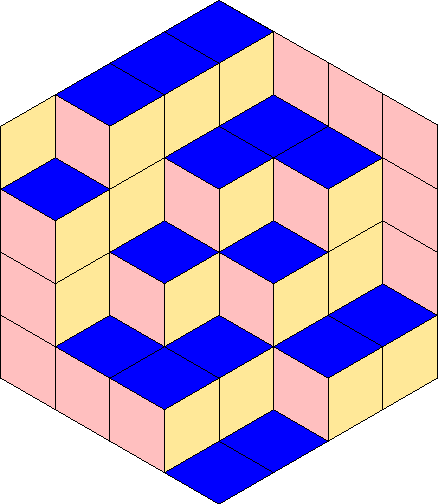Consider a group acting on a set . A -Cameron–Liebler set is a subset of , whose indicator function is a linear combination of the indicator functions of the cosets of the point stabilizers. We investigate Cameron–Liebler sets in permutation groups, with a focus on constructions of Cameron–Liebler sets for -transitive groups.
Revised:
Accepted:
Published online:
DOI: 10.5802/alco.363
Keywords: Cameron–Liebler sets, permutation groups
D’haeseleer, Jozefien 1; Meagher, Karen 2; Pantangi, Venkata Raghu Tej 2
 CC-BY 4.0
CC-BY 4.0
@article{ALCO_2024__7_4_1157_0,
author = {D{\textquoteright}haeseleer, Jozefien and Meagher, Karen and Pantangi, Venkata Raghu Tej},
title = {Cameron{\textendash}Liebler sets in permutation groups},
journal = {Algebraic Combinatorics},
pages = {1157--1182},
publisher = {The Combinatorics Consortium},
volume = {7},
number = {4},
year = {2024},
doi = {10.5802/alco.363},
zbl = {07921889},
language = {en},
url = {https://alco.centre-mersenne.org/articles/10.5802/alco.363/}
}
TY - JOUR AU - D’haeseleer, Jozefien AU - Meagher, Karen AU - Pantangi, Venkata Raghu Tej TI - Cameron–Liebler sets in permutation groups JO - Algebraic Combinatorics PY - 2024 SP - 1157 EP - 1182 VL - 7 IS - 4 PB - The Combinatorics Consortium UR - https://alco.centre-mersenne.org/articles/10.5802/alco.363/ DO - 10.5802/alco.363 LA - en ID - ALCO_2024__7_4_1157_0 ER -
%0 Journal Article %A D’haeseleer, Jozefien %A Meagher, Karen %A Pantangi, Venkata Raghu Tej %T Cameron–Liebler sets in permutation groups %J Algebraic Combinatorics %D 2024 %P 1157-1182 %V 7 %N 4 %I The Combinatorics Consortium %U https://alco.centre-mersenne.org/articles/10.5802/alco.363/ %R 10.5802/alco.363 %G en %F ALCO_2024__7_4_1157_0
D’haeseleer, Jozefien; Meagher, Karen; Pantangi, Venkata Raghu Tej. Cameron–Liebler sets in permutation groups. Algebraic Combinatorics, Volume 7 (2024) no. 4, pp. 1157-1182. doi : 10.5802/alco.363. https://alco.centre-mersenne.org/articles/10.5802/alco.363/
[1] The Erdős–Ko–Rado property for some permutation groups, Australas. J. Combin., Volume 61 (2015), pp. 23-41 | MR | Zbl
[2] The Erdős-Ko-Rado property for some 2-transitive groups, Ann. Comb., Volume 19 (2015) no. 4, pp. 621-640 | DOI | MR | Zbl
[3] On the Erdős–Ko–Rado property for finite groups, J. Algebraic Combin., Volume 42 (2015) no. 1, pp. 111-128 | DOI | MR | Zbl
[4] On the orbits of collineation groups, Math. Z., Volume 96 (1967), pp. 33-49 | DOI | MR | Zbl
[5] Theory of groups of finite order, Dover Publications, Inc., New York, 1955, xxiv+512 pages (2d ed) | MR
[6] Tactical decompositions and orbits of projective groups, Linear Algebra Appl., Volume 46 (1982), pp. 91-102 | DOI | MR | Zbl
[7] Intersecting families of permutations, European J. Combin., Volume 24 (2003) no. 7, pp. 881-890 | DOI | MR | Zbl
[8] Cameron–Liebler line classes of admitting , J. Combin. Theory Ser. A, Volume 167 (2019), pp. 104-120 | DOI | MR | Zbl
[9] Equivalent definitions for (degree one) Cameron–Liebler classes of generators in finite classical polar spaces, Discrete Math., Volume 343 (2020) no. 1, Paper no. 111642, 13 pages | DOI | MR | Zbl
[10] Cameron–Liebler sets of generators in finite classical polar spaces, J. Combin. Theory Ser. A, Volume 167 (2019), pp. 340-388 | DOI | MR | Zbl
[11] The Cameron–Liebler problem for sets, Discrete Math., Volume 339 (2016) no. 2, pp. 470-474 | DOI | MR | Zbl
[12] Intriguing sets of vertices of regular graphs, Graphs Combin., Volume 26 (2010) no. 5, pp. 629-646 | DOI | MR | Zbl
[13] Cameron–Liebler line classes in AG, Finite Fields Appl., Volume 67 (2020), Paper no. 101706, 17 pages | DOI | MR | Zbl
[14] Permutation groups, Graduate Texts in Mathematics, 163, Springer Science & Business Media, 1996, xii+346 pages | DOI | MR
[15] Sharply transitive sets in , Adv. Geom., Volume 21 (2021) no. 4, pp. 611-612 | DOI | MR | Zbl
[16] Setwise intersecting families of permutations, J. Combin. Theory Ser. A, Volume 119 (2012) no. 4, pp. 825-849 | DOI | MR | Zbl
[17] Intersecting families of permutations, J. Amer. Math. Soc., Volume 24 (2011) no. 3, pp. 649-682 | DOI | MR | Zbl
[18] Intersection theorems for finite general linear groups, Math. Proc. Cambridge Philos. Soc., Volume 175 (2023) no. 1, pp. 129-160 | DOI | MR | Zbl
[19] Boolean degree 1 functions on some classical association schemes, J. Combin. Theory Ser. A, Volume 162 (2019), pp. 241-270 | DOI | MR | Zbl
[20] A modular equality for Cameron–Liebler line classes, J. Combin. Theory Ser. A, Volume 127 (2014), pp. 224-242 | DOI | MR | Zbl
[21] Erdős–Ko–Rado Theorems: Algebraic Approaches, Cambridge Studies in Advanced Mathematics, Cambridge University Press, 2016 no. 149 | MR
[22] Intersection density of transitive groups of certain degrees, Algebr. Comb., Volume 5 (2022) no. 2, pp. 289-297 | DOI | Numdam | MR | Zbl
[23] Endliche Gruppen. I, Grundlehren der Mathematischen Wissenschaften, 134, Springer-Verlag, Berlin-New York, 1967, xii+793 pages | DOI | MR
[24] Character sums and double cosets, J. Algebra, Volume 320 (2008) no. 10, pp. 3749-3764 | DOI | MR | Zbl
[25] Character theory of finite groups, Pure and Applied Mathematics, No. 69, Academic Press [Harcourt Brace Jovanovich, Publishers], New York-London, 1976, xii+303 pages | MR
[26] The subgroup structure of finite classical groups in terms of geometric configurations, Surveys in combinatorics 2005 (London Math. Soc. Lecture Note Ser.), Volume 327, Cambridge Univ. Press, Cambridge, 2005, pp. 29-56 | DOI | MR | Zbl
[27] Intersecting families in the alternating group and direct product of symmetric groups, Electron. J. Combin., Volume 14 (2007) no. 1, Paper no. 25, 15 pages | DOI | MR | Zbl
[28] On the EKR-module property, Algebr. Comb., Volume 7 (2024) no. 2, pp. 577-596 | MR | Zbl
[29] Erdős–Ko–Rado problems for permutation groups, 2020 | arXiv
[30] Characterization of intersecting families of maximum size in , J. Combin. Theory Ser. A, Volume 157 (2018), pp. 461-499 | DOI | MR | Zbl
[31] An Erdős–Ko–Rado theorem for the group , Des. Codes Cryptogr., Volume 87 (2019) no. 4, pp. 717-744 | DOI | MR | Zbl
[32] Some Erdős–Ko–Rado results for linear and affine groups of degree two, Art Discrete Appl. Math., Volume 6 (2023) no. 1, Paper no. 1.05, 30 pages | DOI | MR | Zbl
[33] All 2-transitive groups have the EKR-module property, J. Combin. Theory Ser. A, Volume 177 (2021), Paper no. 105322, 21 pages | DOI | MR | Zbl
[34] An Erdős–Ko–Rado theorem for the derangement graph of PGL(2, q) acting on the projective line, J. Combin. Theory Ser. A, Volume 118 (2011) no. 2, pp. 532-544 | DOI | MR | Zbl
[35] An Erdős–Ko–Rado theorem for finite 2-transitive groups, European J. Combin., Volume 55 (2016), pp. 100-118 | DOI | MR | Zbl
[36] An improved bound on the existence of Cameron–Liebler line classes, J. Combin. Theory Ser. A, Volume 121 (2014), pp. 89-93 | DOI | MR | Zbl
[37] Completely regular codes in Johnson and Grassmann graphs with small covering radii, Electron. J. Combin., Volume 29 (2022) no. 2, Paper no. 2.57, 15 pages | DOI | MR | Zbl
[38] Cameron–Liebler Sets for 2-Transitive Groups, Masters thesis, University of Regina (2020)
[39] Complex representations of for finite fields , Contemporary Mathematics, 16, American Mathematical Society, Providence, RI, 1983, vii+71 pages | MR
[40] The symmetric group: Representations, combinatorial algorithms, and symmetric functions, The Wadsworth & Brooks/Cole Mathematics Series, Wadsworth & Brooks/Cole Advanced Books & Software, Pacific Grove, CA, 1991, xviii+197 pages | MR
[41] The Erdős–Ko–Rado theorem for the derangement graph of the projective general linear group acting on the projective space, J. Combin. Theory Ser. A, Volume 166 (2019), pp. 59-90 | DOI | MR | Zbl
[42] An Erdős–Ko–Rado-type theorem in Coxeter groups, European J. Combin., Volume 29 (2008) no. 5, pp. 1112-1115 | DOI | MR | Zbl
Cited by Sources:


